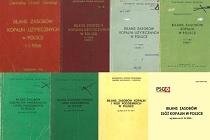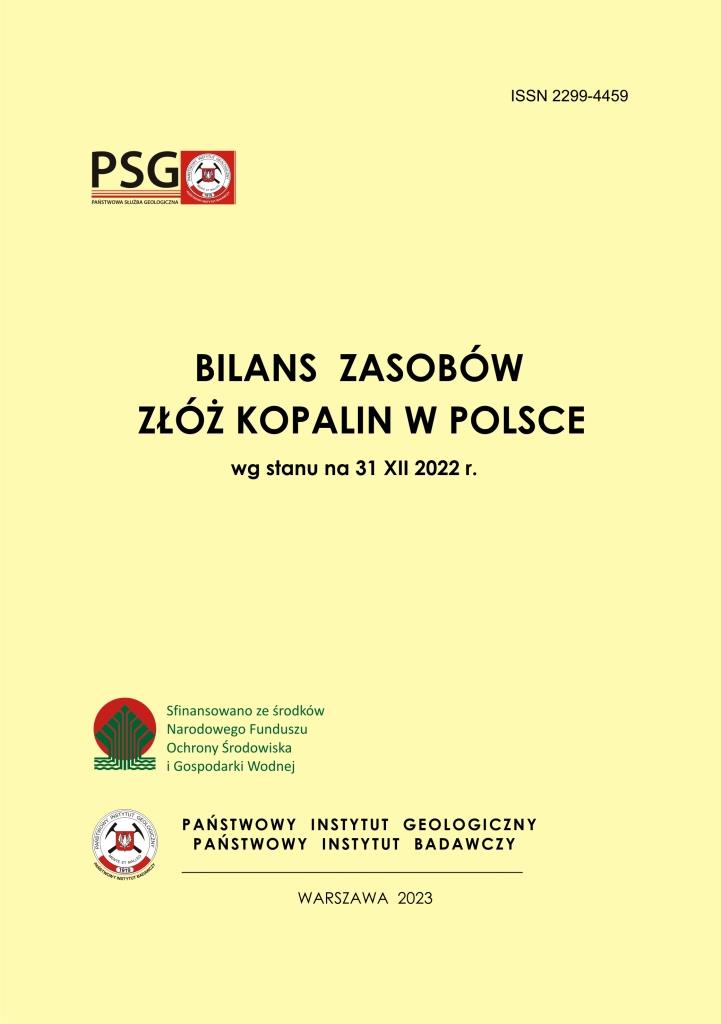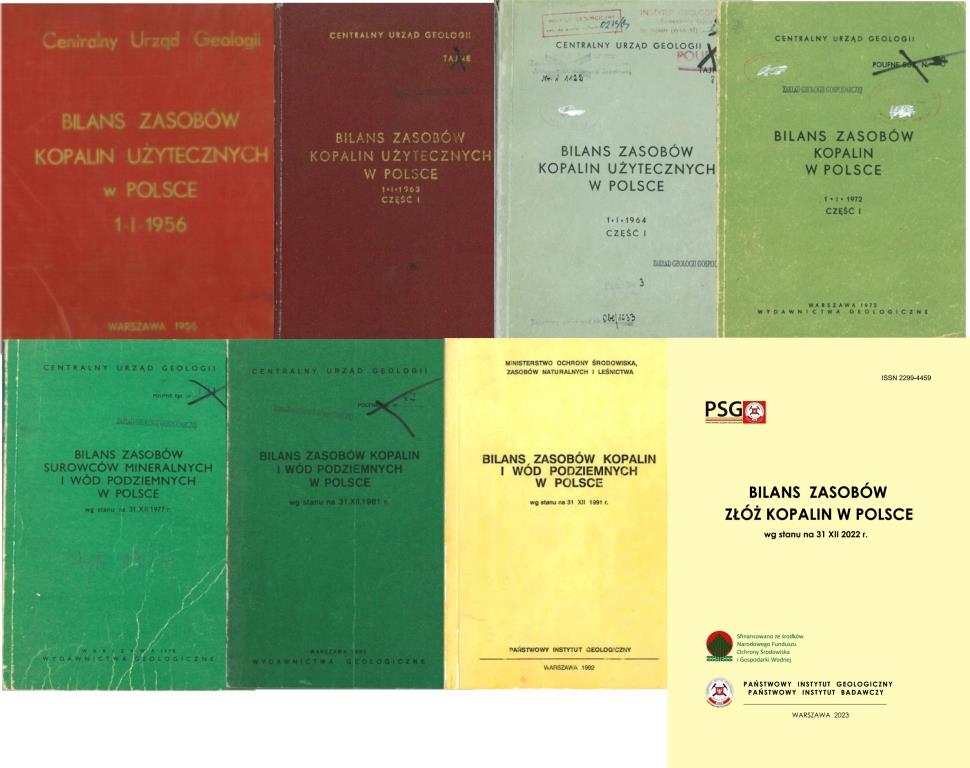 In the more than 100-year history of the Polish Geological Institute - National Research Institute (PIG-NRI), it is worth emphasising the role and importance of balancing mineral deposits in Poland.
In the more than 100-year history of the Polish Geological Institute - National Research Institute (PIG-NRI), it is worth emphasising the role and importance of balancing mineral deposits in Poland.

For years, it has been a very important part of the tasks carried out by PGI-NRI for the Polish Geological Survey (PGS). "The Balance of Mineral Deposit Resources in Poland" is an annual report on the status of documented and developed domestic mineral deposits - resources, extraction and utilisation of minerals and the location of individual deposits. In 2023, the balance was compiled for the 70th time, so it is worth highlighting its role as a tool to support state policy in the raw material wealth management sector.
The first book edition - initiated by prof. Andrzej Bolewski, then President of the Central Office of Geology (CUG) - was compiled in 1953. Unfortunately, like the 1954 edition, it has not survived in the available archives. Starting with the 1955 edition, all subsequent editions have been collected at the PGI-NRI headquarters in Warsaw, both in hard copy and - to meet the needs of all those interested - in digital form, available on the PGI-PIB dedicated website: https://www.pgi.gov.pl/bilans-zasobow.
Over time, the entities responsible for preparing the balance have changed. For the first 32 years it was the Central Office of Geology and then, for a further two years, the Ministry of Environmental Protection and Natural Resources. Since 1988, the publication has been compiled by PGI-NRI - initially in the Department of Economic Geology, then in the Department of Information on Deposits and Mining Areas, the Deposit and Economic Geology Programme, and now in the Department of Deposit and Economic Geology.

The publication has changed its title over the years, but its substantive content has always been presented in a similar form as today. Each time, the authors emphasised the reliable and clear presentation of information on mineral deposits in Poland, divided into mineral groups (energy, metallic, chemical, rock and underground water) - based on their raw material suitability.
Now, in the chapters on individual minerals, the reader can find:
- description of deposit areas,
- description of the nature of the deposits,
- description of the quality of the minerals and their possible uses,
- resource and extraction tables at national, regional or provincial level.
Maps of the distribution of the individual mineral deposits have always been an integral part of the publication - an extremely important supplement to the textual information, which is also of keen interest to both government and local government entities and individual users.
In order to disseminate the balance as widely as possible and to facilitate the use of the information contained therein, in 2011 PGI-NRI created a website dedicated to the publication, Mineral Raw Materials of Poland, available at https://geoportal.pgi.gov.pl/surowce.
This website, which is prepared in both Polish and English, is updated annually with the latest edition of the 'Balance...' and, just as importantly, is an extension of it with a number of extremely important elements. These are:
- graphical presentation of multi-year resource and extraction data,
- a set of maps of the distribution of mineral deposits under mining ownership and other more important mineral groups,
- maps of concessions for exploration, prospecting and extraction of minerals from deposits under the jurisdiction of the minister responsible for the environment, and of therapeutic, thermal and brine waters,
- reference to spatial data on mineral deposits, mining areas and sites, which are made available in vector format in .shp (shapefile) on http://dm.pgi.gov.pl/ and in raster format by means of WMS services at http://geoportal.pgi.gov.pl/uslugi_gis and in PIG-PIB's spatial information portal http://geologia.pgi.gov.pl, a chapter devoted to the export and import of mineral resources in Poland, in terms of both volume and value of trade.
The site Mineral Raw Materials of Poland also includes:
- all previous editions of the English-language version of the "Balance...", entitled "Mineral Resources of Poland" - published by PGI-NRI since 1995 in a cycle of several years (6 editions in total),
- all previous editions of the publication "Balance of Prospective Mineral Resources of Poland" - issued by PGI-NRI since 1971 (6 editions in total),
- "Balance of the Mineral Raw Materials Economy of Poland and the World" (2 editions),
- "Minerals Yearbook of Poland" (2 editions).
We would like to emphasise very clearly that the final effect in the form of the "Balance" and subsequent parts of the above-mentioned website, is the fruit of year-long work of a whole team of people and is based on processed information coming from geological documentation, supplements to the documentation, regularly collected in the National Geological Archives (NAG), as well as statistical forms submitted to PGI-PIB by users of the deposits.
For many years the basis for compilation of this periodical has been the Mineral Resources Management and Protection System of Poland (MIDAS), which, apart from the data used for preparation of the "Balance", collects most of the basic descriptive and spatial information on mineral deposits in Poland https://www.pgi.gov.pl/midas.
In order to illustrate the changes taking place in the preparation of the balance over the past 70 years, a few figures can be quoted here:
- in the early years of the publication, the number of deposits discussed did not exceed several hundred,
- in 1960, the number of deposits was higher than 1 000 for the first time,
- in 1986, the number of deposits exceeded 4 000,
- in 2014, the number of deposits was higher than 13,000,
- the latest edition of the "Balance” contained information on 14,780 deposits.
The next edition will be published as early as June 2024.
At this point, we would like to express our immense gratitude to all past and present editors of the publication, authors of individual chapters and authors of the graphic part. It is impossible to name individually everyone who has contributed to the very rich history of this project, but everyone must nevertheless be acknowledged for their enormous contribution to this long-standing project.














 PGI-NRI offer
PGI-NRI offer Mineral resources of Poland
Mineral resources of Poland  Oil and Gas in Poland
Oil and Gas in Poland 




 Subscribe to RSS Feed
Subscribe to RSS Feed